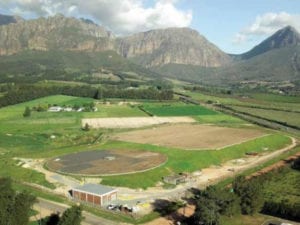Deemed a first of its kind in South Africa, the Leliefontein Pump-As-Turbine Station in Drakenstein Municipality generates electricity while transferring water.
Originally intended to be a booster station to supply water to Wellington during summer peak demand, Leliefontein’s location within DrakensteinMunicipality’s bulk water network is prime for a productive mini hydropower station. While using pumps-as-turbines (PATs) is not a new technology, Leliefontein uniquely uses the same set of pumps to pump water and generate electricity by reversing flow through the pumps. This is achieved by the innovative use of active front-end variable-speed drives (AFE VSDs) to lower the speed of the PATs to generate electricity at the available flow rates, a series of actuated valves, and some creative pipework. The power generated at the station is fed back into the municipal grid, offsetting the power consumed during pumping.
Purpose of the project
The bulk water supply to Drakenstein comes from the Wemmershoek Water Treatment Works to Leliefontein reservoir in Paarl. It consists of a 100 Mℓ and 36 Mℓ reservoir, serving the town of Paarl. This gravity pipeline also supplies water to Wellington’s Con Marine and Newton zone reservoirs, at a maximum capacity of 19 Mℓ/day. There are periods when the supply from Wemmershoek is interrupted, either due to planned maintenance or unplanned repair work. When this occurs, water from the Leliefontein reservoirs can gravitate towards Wellington at a maximum capacity of 11.2 Mℓ/day. According to Hein Henning, engineer: Water Services Operations, Drakenstein Municipality, this capacity is currently sufficient to meet Wellington’s winter demand, but not its summer demand. The upgrading of the Leliefontein-toWellington supply system was included in Drakenstein Municipality’s bulk water masterplan and a pump station was identified as the most suitable method to increase the conveyance capacity to 30 Mℓ/day. However, the initial plan meant that the pump station was only going tobe used a few weeks in the year, with the pumps standing idle most of the time. A new plan had to be made to utilise the installation for most of the year. Solving the problem “Drakenstein Municipality appointed Aurecon Consulting Engineers to assist with solving the problem and many brainstorming hours were spent to come up with a solution. The PAT concept was eagerly adopted by all parties and the crunch time to get the correct design, technology, equipment and approvals started,” says Henning. “The budget was also a major factor to be considered. Due the topography of the Leliefontein reservoir site, the pumps would have to be installed below ground to ensure sufficient suction head.” A PAT is essentially a centrifugal pump, which can be used as a turbine by reversing the direction of water flow through the pump and reversing the rotation of the pump shaft. An options analysis determined PAT to be the preferred turbine option for this installation because it offered several advantages, including lower capital costs, no increase in footprint of the pump station, ease of maintenance, and utilisation of off-the-shelf equipment.
Pump station design
The main objective of the project was to design and build an efficient and easily upgradable pump station. The design approach for the pump station is as follows:
- three end-suction centrifugal pumps in two duty/one standby configuration, with allowance for a fourth pump in future; each pump supplied with a 185 kW fourpole induction motor
- stainless steel suction and delivery pipework, with suction and delivery isolation valves and discharge non- return valves
- a motor control centre (MCC) equipped with three 185 kW VSDs (with spare cubicle for future drive), logic controller for automatic control and monitoring of the installation, and changeover compartments for the mains and backup generator power
- 550 kVA diesel standby generator for backup power during pumping
- 1 MVA transformer for bulk power supply
- radio telemetry and monitoring SCADA at the municipal offices
- underground HDPE suction (DN900, drawing from Leliefontein reservoirs) and delivery (DN630, pumping into the existing DN500/450 AC pipeline towards Wellington) pipelines, with offtake isolation valve chambers
- pump station building to house the pumps, MCC room and diesel generator with LED lighting
- electrified security perimeter fence, including access gates and paved access road to the pump station.








